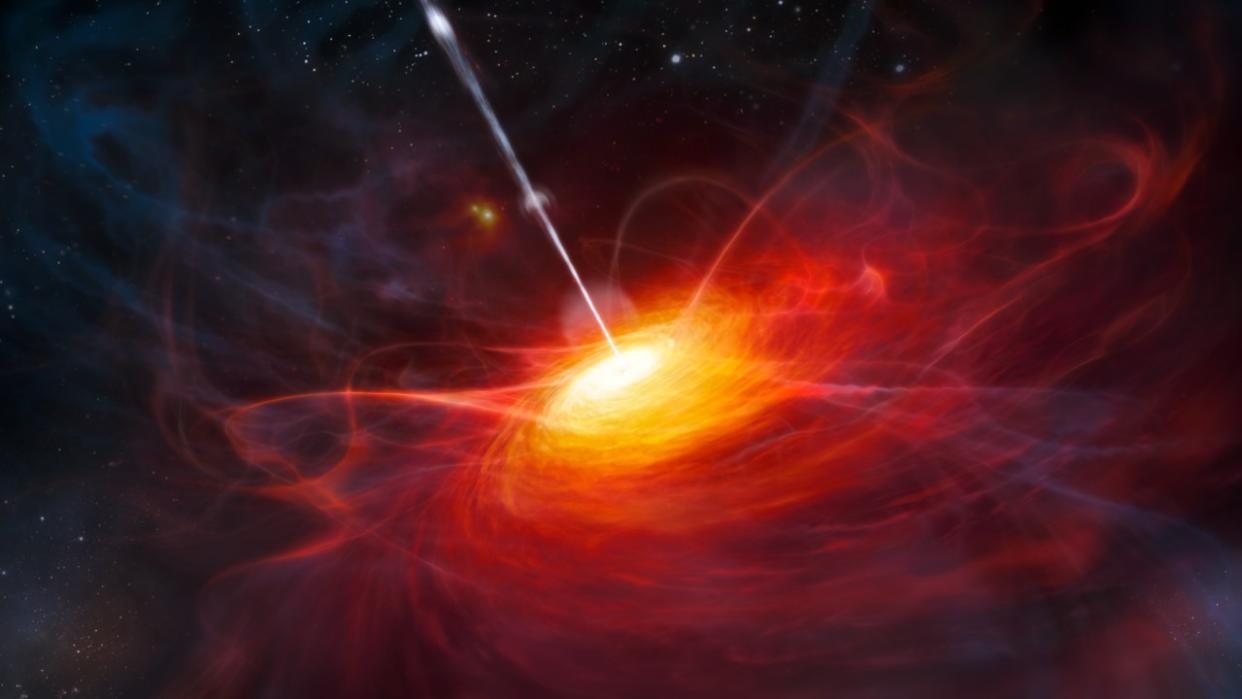Supermassive black holes grow surprisingly quickly, study suggests

There were more monstrous black holes in the early universe than previously thought, a new study suggests.
A new way to predict the masses of the largest supermassive black holes believed to lurk at the heart of most galaxies has shown that these cosmic titans may grow faster than previously believed.
The results, from novel computer modeling methods, suggest that, billions of years ago, black holes may have been larger than scientists had thought. This is a potential breakthrough, because it could help researchers understand how supermassive black holes reach such tremendous sizes.
"The black hole at the center of our galaxy is millions of times the mass of the sun, but we also see others that we think are billions of times the mass of the sun," study author Joseph Simon, a postdoctoral researcher at the University of Colorado, Boulder, said in a statement. "We have really good measurements for the masses of the supermassive black holes for our own galaxy and for galaxies close by. We don't have those same kinds of measurements for galaxies farther away. We just have to guess."
Related: 100 black hole jets aimed at Earth unleash controversial physics theory
The two supermassive black holes that humanity has imaged so far serve as startling examples of just how large a mass range these cosmic monsters span. Sagittarius A* (Sgr A*), at the heart of the Milky Way, has a mass equal to around 4.5 million suns. The black hole that lurks within the galaxy M87, located around 6 million light-years away, has a mass equal to around 5 billion suns, however.
There are several theories about how supermassive black holes grow to incredible sizes, most of which involve the mergers of smaller black holes.
But there's a problem with this idea: Has there been enough time in the 13.8-billion-year history of the universe for these processes to grow supermassive black holes so big, especially the ones that existed billions of years ago?
"There's been the expectation that you would only see these really massive systems in the nearby universe," Simon said. "It takes time for black holes to grow."
Black holes were massive in the early universe
As colliding black holes swirl around each other, they send gravitational waves — ripples in space-time that Einstein's theory of general relativity says are created by massive accelerating objects — flowing out through space. The final clash of the black holes sends out a massive burst of gravitational waves signaling the merger. Some of these waves eventually wash over Earth and carry information about the events that created them.
Simon is part of an effort called the North American Nanohertz Observatory for Gravitational Waves (NANOGrav), which has been hunting for a steady flow of gravitational waves called the "gravitational wave background." But, to fully understand this, scientists need to know the masses of supermassive black holes through cosmic history.
To develop a new way of determining black hole masses, even for distant examples, Simon gathered information about hundreds of thousands of galaxies, some of which are so far away that they are seen as they were billions of years ago. With this data, the researcher calculated black hole masses for some of the largest galaxies in the universe. He then employed computer modeling to simulate the gravitational waves that these objects would create.
This gave Simon a spread of masses for black holes in the universe dating back roughly four billion years. The data showed something unexpected: There was a larger selection of big galaxies and huge supermassive black holes in the universe billions of years ago than currently predicted.
RELATED STORIES:
— The loneliest monster black holes may also be the hungriest
— Sagittarius A* in pictures: The 1st photo of the Milky Way's monster black hole explained in images
The new research suggests that these monstrous supermassive black holes may not need as much time to grow as previously theorized. Similar conclusions have been reached by astronomers who have spotted unexpectedly large black holes lurking in the early universe.
In the next steps for this research, Simon intends to investigate black holes located even farther away from Earth and thus seen even earlier in cosmic history. He hopes that this investigation could help reveal how galaxies like the Milky Way form, given that supermassive black holes exert a tremendous influence over the galaxies that host them.
"Understanding the masses of black holes is critical to some of these foundational questions like the gravitational wave background, but also how galaxies grow and how our universe has evolved," he concluded.
The research was published in the May 30 edition of The Astrophysical Journal Letters.